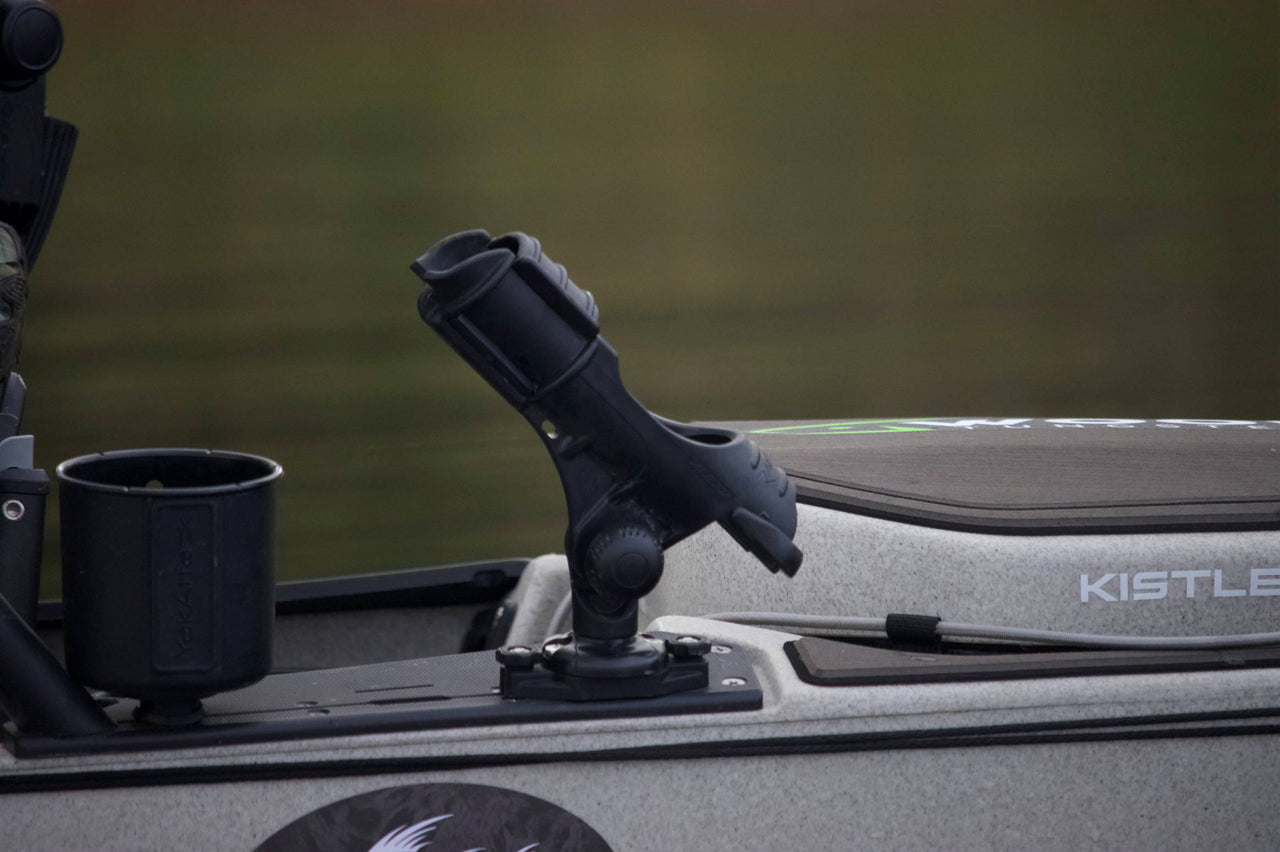From offshore trolling with extensive rigging to inland honeyholes where you’re watching a handful of rods with bobber lines, it matters what rod holder types you choose to use on your boat. But with all the options out there, it’s no wonder why anglers are routinely seeking information to help them find the best match for their boat and target fish.

Customer Q&A: What Rod Holder Should I Use on My Boat?
A Rod Holder Guide for Any Angler
They can be simple and convenient, innovative and adaptable, subtle and sleek, and so much more, but sorting through the options can be a challenge, so here’s our guide designed to help you choose the right one.
 1. Wire Fishing Rod Holders
1. Wire Fishing Rod Holders
Primary Uses: Used for active fishing circumstances, wire fishing rod holders are a no-frills solution for a variety of locations and fish. For the best match, we recommend them for more economical fishing applications, casual fishing, or fishing with rods that don’t need the extra cushion, grip, and versatility that you can find in other types of rod holders.
Benefits: Wire fishing rod holders are designed to be easy to use, simple to mount, and very cost-effective.
Boat Applications: Jon Boats, Paddle Boats, and Docks.
Cautions: If you need a rod holder that offers additional features and protections for your rod, a wire rod holder may not be your best match. This is especially true if you need cushion to protect your rod, extra grip to hold it in place, adjustability, transferability, and durability.
 2. Vertical Mount Removable Rod Holders
2. Vertical Mount Removable Rod Holders
Primary Uses: Vertical mount removable rod holders are a relatively simple-but-upgraded rod holder option, suitable for active fishing on various waters and for various fish — even offshore saltwater fish. They’re a particularly good fit when you need a solid rod holder but you don’t need it on a gimbal, you don’t have rails for mounting, or your boat isn’t a good fit for rod holders that require more space and extensive mounting work.
Benefits: Anglers love this rod holder because it has excellent durability and performance along with a clean, premium look. It’s also easy to install, pretty gentle on rods, and convenient to slide off the mount and stow away when not in use.
Boat Applications: Center Consoles, Bay Boats, Deep V Fishing and Multi-Purpose Boats, and Paddle Boats.
Cautions: Make sure to mount this rod holder vertically — the rod holder portion is meant to slide down and in to keep it in place, but if it’s mounted horizontally, it could slide backward and off your boat. Also bear in mind that, aside from being able to remove it when not in use, this rod holder does not have adjustable positioning.
 3. Clamp-on Fishing Rod Holders
3. Clamp-on Fishing Rod Holders
Primary Uses: Much the same as vertical mount removable rod holders, clamp-on fishing rod holders are an active-fishing rod holder suitable for a variety of waters and various fish, even many offshore saltwater species. The main difference comes down to how and where you can secure them to your boat.
Benefits: This rod holder option really shines if you have rails and tubing for mounting them, which then gives you versatility in where you mount them and with how many you mount on your boat. They also tend to give you options for adjusting the angle and positioning of the rod as well as a fairly convenient means of removing the tube for storage. And, like the previous rod holders on this list, they’re made with durability and performance in mind and are pretty gentle on rods.
Boat Applications: For a variety of boats with rails and clamping spots, including many Center Consoles, Bay Boats, Pontoons, Deep V Fishing and Multi-Purpose Boats, and some Paddle Boats.
Cautions: Clamp on rod holders are mostly limited by the availability of railing / mounting spots. Aside from that, some boaters choose other rod holder options because clamp on rod holders take more effort to remove and stow than vertical mount removable rod holders and they don’t look as sleek and clean as flush mount rod holders.
 4. Cradle-Style Rod Holders
4. Cradle-Style Rod Holders
Primary Uses: Cradle-style rod holders can come in a variety of looks and with a variety of mounting options, but they all provide strength, support, and moderate-to-exceptional versatility. Though they’re an active-fishing rod holder suitable for a variety of fish, you’ll typically see them on fishing kayaks and freshwater fishing boats, including those used for walleye, pike, catfish, perch, and various sunfishes.
Benefits: Cradle-style rod holders are quite universal in their nature, and you can often find them paired with surface mounts, clamps, rail mounts, and other mounting options, too. These mounting styles typically go hand-in-hand with how transferable and stowable these rod holders are. Additionally, to provide cushion for your rod while also providing a good hold and superior adaptability, many cradle rod holders are built with foam padding on the inside of the cradle.
Boat Applications: Just about any boat with a mounting spot for either a surface mount, a clamp, or a rail mount, including Center Consoles, Pontoons, Deep V Fishing and Multi-Purpose Boats, Jon Boats, Kayaks, and Paddle Boats.
Cautions: Since most are plastic with an upward extension between the mount and the cradle sitting above, we wouldn’t recommend them to anglers who want to use them when actively fishing for larger fish species, especially offshore. Also be advised that some rod and reel combos may require a cradle rod holder with a collar or strap for a solid hold, and, unlike vertical mount removable rod holders, cradle rod holders are typically unable to be mounted safely to a tall vertical surface.
 5. Flush Mount Rod Holders
5. Flush Mount Rod Holders
Primary Uses: Flush mount rod holders are the optimal, dual-purpose rod holder for active fishing and rod storage on any boat where you have a good place to mount them. They’re even a great fit for rods being used to catch big fish offshore, making them a popular option for bigger boats and those who pair them with outriggers.
Benefits: Flush mount rod holders are sleek, strong, and durable as they couple the strength of the rod holder with the mounting area inset on the surface of the boat. They also come in a variety of angles and finishes.
Boat Applications: Large Saltwater Boats, Center Consoles, Charter Boats, Bay Boats, and Kayaks.
Cautions: To install a flush mount rod holder directly onto your boat, it will require cutting a hole, which can make some boat owners uneasy. Not only will you want to drill with precision, you’ll want to make sure the space is clear below the mounting spot and you’ll want to manage any drainage that may come through the rod holder and into your boat.
 6. Molded Rod Holders
6. Molded Rod Holders
Primary Uses: You’ll typically see molded rod holders on bigger boats, geared up for catching bigger fish. They’ll be mounted near a center console, behind seats, or in other vertical-mounting spaces at the back of a boat. They’re perfect for providing an accessible rod storage spot, especially when you need racks of three or more. However, there are plenty of use cases for smaller scale use, mounting single units, and sometimes using them for active fishing, too.
Benefits: Molded rod holders have an elongated, rugged, self-draining, and easy-to-clean design. They can also come in a variety of colors and styles and can come with great features built into them, including storage spots for lures and tools.
Boat Applications: Large Saltwater Boats, Center Consoles, Charter Boats, Bay Boats, Multi-Species Fishing Boats, Kayaks (single or doubles can be a good fit for kayak crates), Docks, and Paddle Boats.
Cautions: Since molded rod holders are primarily designed for storage, they only have a limited ability to hold a rod in the right position for fishing. It can also require much more surface area for mounting when compared to cradle rod holders and vertical mount removable rod holders. They tend to be made of rugged plastic, but their durability can vary depending on the manufacturer and extreme weather conditions.
Don’t Forget Rod Storage Options
When do you need to store your rods? For many of us, it’s any time when they aren’t getting active use and when we need to keep them reasonably accessible (but also out of the way). This helps prevent them from getting tripped on, busted, and jammed up with dirt, especially on boats that are used for more than fishing.
Rod organization is another topic unto itself, but keep in mind that there are some great solutions for rod storage as well. This includes rod tamers, rod straps, rod tubes, foam rod holder racks, and other options that complement your rod holders and help you stay organized.
Now that You Know When (and How) to Hold’em
With deeper insight into your rod holder options, what they can do and what they require, you don’t have to gamble with where you put your rods. Just pick the right fit for your boat and the effort you want to put into rigging it, and you’ll be well on your way to better rod storage and a more perfect trolling setup.






